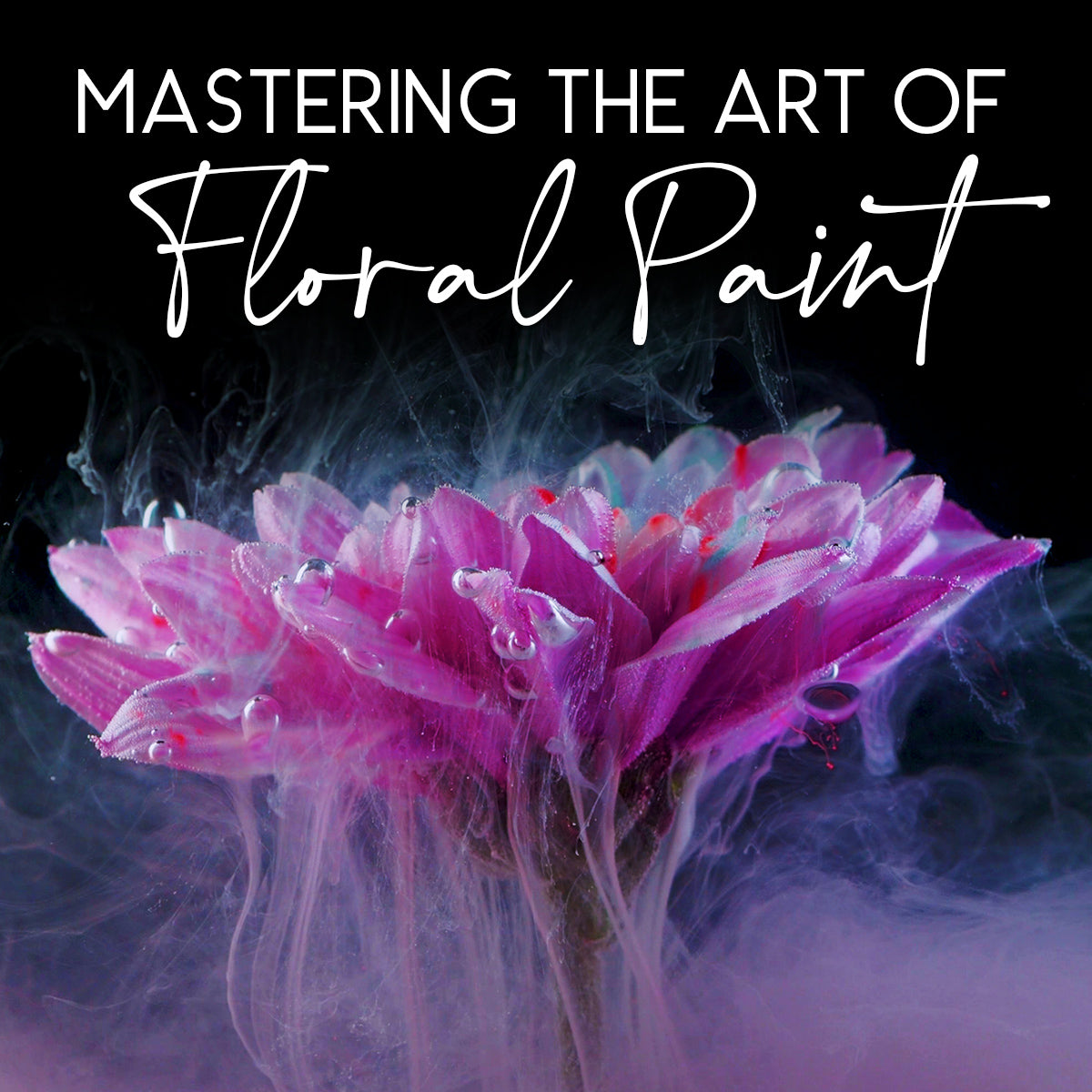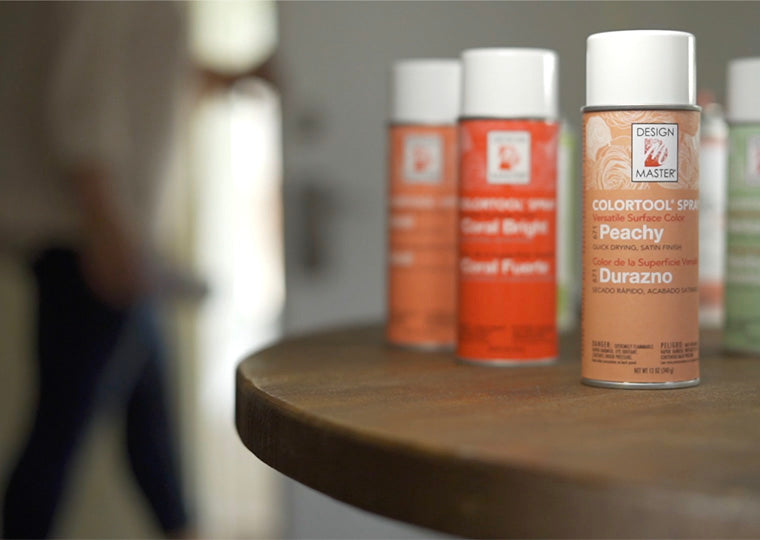


Sharon McGukin
Smithers-Oasis North America Design Director Sharon McGukin, AIFD, AAF, PFCI enjoys sharing floral tips and techniques for celebrating life with flowers.

Photo: Design Master
(Lavender mum misted to tone and muddy the color with 3 options – Red Clay, Honeycomb, and Thicket.)
There's something magical about changing a flower’s color. Floral designers often experience creative satisfaction while ‘mastering the art of floral paint.’
Transforming a bloom from what it was to something fresh and reinvigorating. Instant gratification. Creative solutions. Something new to you.
Gretchen's Sell - education and creative director of Design Master, suggests two primary functions for the use of floral paint (aka color spray), “problem solver and creative tool.”
Problem Solver
In a time of flower shortages and delayed deliveries, alterations and substitutions become a problem-solving necessity. As a result, color sprayed materials are trending for flowers and foliages.
“You might view Design Master as the Red Cross of color - delivering ‘color first aid,’” says Gretchen. “We've come to the rescue in countless situations where a flower color is ordered but the item that arrived isn't what was desired.” Fortunately, designers are inherently creative.
Creative Tool
Floral artists use color spray as a creative tool. “Creatives are taking the artist's approach to design,” Gretchen explains. “They want to control flower color palettes, like a painter does. They are color spraying blooms, foliage, and accessories and using the color elements in their floral artwork.
This direction is stretching the traditional view of floristry, perhaps a bit of avant-garde, but it's really exciting.” Why is color spray the best application for this use?

Photo: Design Master
(Tiger Lily on yellow ranunculus shows how texture can influence resulting color… creating a bicolor bloom.)
Color Spray vs Hardware Paint
DM color sprays are safe on flowers and fast drying for ease of use. “There’s a difference between Design Master color spray and hardware paint,” says Gretchen, “They are two totally different formulations. Ours are modified lacquer base sprays and the majority of typical hardware store spray paints are enamel sprays.”
Design Master color sprays were developed over 60 years ago, specifically for the floral industry.
“They are safe to use on delicate surfaces like fresh flowers, ribbons, tulle, and paper, but also for durable surfaces that traditional hardware store paints are used on like wicker, wood, metal, and glass,” Gretchen explains.
If you aren’t sure which DM paints are for what purpose visit dmcolor.com. The different types of products are available in categories and as individual products. There’s also a color shifting brochure on the website under the Inspiration tab.
Versatility is key. “Application techniques are much greater than what you can do with hardware store paints.” All Design Master color products can be used with one another in light layers to blend colors. Allowing you to create unique finishes by color shifting.
Color Shift

Photo: Design Master
(Pink Glow on Orange – makes a fun neon-ish pink!)
Color shifting is the principle of working with color-on-color and pushing color direction. “Perhaps it needs to shift a little toward blue or a little more red. You can accomplish this with color sprays.” Design Master color products are delivered in an ultra-fine mist which helps when shifting colors.
“For example, if you need a peach-tone bloom that you don't have. Peach albeit, a lighter value, has an influence of red and yellow. Select light valued colors of yellow and red. Mist a soft yellow flower with a pink color spray to create the flower color you need,” Gretchen continues. A monochromatic shift is basically shifting the value of a color.
“If you have a light-colored flower, say in pink, and you want a deeper pink choose a deeper colored spray to create what you need.”
Color Spraying Fresh Flowers
“One short-term lifesaver, especially for event florists, is that you can conceal blemishes on pricey blossoms and avoid losing profits,” says Gretchen. White flowers seem to show blemishes the most. Blooms like lilies, orchids and roses, as they get a little older, start to look a somewhat transparent. You can bump up the color by spraying Color Tool Flat White on the backside of the blooms. Making them usable for a short-term event, so you're not tossing a pricey blossom out. The color will look natural, but stronger.
“Hydrangea, the darling of the flower world, is another great canvas for spray color.” Sometimes you need a color that’s not available and can spray it. Many florists have revealed that they buy less expensive white, green, or blue varieties and shift the colors to make them look a pricey antique hydrangea. They can charge as much and make more profit.
Be cautious while spraying. “The propellant in color spray is very cold when delivered out of the nozzle. To avoid freezing petals hold the can a distance of 15 to 18 inches from the flower,” Gretchen continues. This allows the propellant to evaporate before the color lands on its surface. “When you've sprayed too close, and there is petal freezing, you'll see a browning of the bloom.”
Color Spraying Foliages
Color spraying foliages is another interesting way to add color or texture to a design. Foliages have varying textures. Some hold color stronger than others. Test spraying a leaf is a good idea to determine results.
Prior to color spraying, it’s important to see that the surface is free of any kind of oily residue or leaf shine. “Sometimes in production and packaging from the grower a leaf shine has been applied. This can interfere with the adhesion of the spray,” explains Gretchen. One way to remove the oils is to use a very soft cloth and rub the surface. At times, a light solution of detergent and water may be needed to help cut through the oils.
When spraying a large leaf like a monstera, start with a coat of silver. “Basically, silver acts like a primer,” Gretchen suggests. “When you need to go from dark to light color or cut interference from a base color, spray first with silver then with your desired color.” This helps to achieve a clean application of the color finish.
Try this paint saving tip - color spray multiple materials at once. For instance, several large foliage leaves. Position a drop cloth, plastic sheeting, or cardboard on the floor below to catch paint overspray. Lay the leaves you're going to spray next atop the material on the floor. As you're color spraying one item in-hand, the extra mist falls down on the other items and it begins to cover them. The overspray will begin to lightly coat the materials you'll be spraying next.

Photo: Design Master
(Monstera leaf with Super Silver primer to enhance the brighter Raspberry color. Reduces the number of coats needed.)
Need More Free Tips?
To hear more of Gretchen’s tips, techniques and ideas, listen to our recent Mastering the Art of Floral Paint podcast on How we Bloom. Be sure to subscribe. You don’t want to miss our upcoming guests.
“Our Cans in your Hands!”

Photo: Design Master
Why have floral paints been is short supply? “During the pandemic, manufacturing was focused on essential items. The factory that has manufactured Design Master products on a dedicated production line for over 60 years, reallocated resources to produce disinfectants and sanitizers,” Gretchen explains.
As a result, inventory was totally wiped out as the demand for color sprays increased. Raw materials were in short supply. This created an unprecedented strain on distribution. Fortunately, factory shipments have been coming in more frequently in recent months.
“As soon as inventory is received at our warehouse, it's off to our distributor where it's quickly purchased by our loyal customers,” Gretchen adds cheerfully.
“We appreciate everyone's patience and understanding. Nothing frustrates us more than not being able to get “our cans in your hands!”
